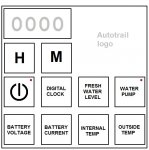GeoffL
Full Member
- Posts
- 2,433
- Likes
- 7,734
I have electrical issues with my 2001 Autotrail Scout (Ducato based) that I suspect might be due to a duff EMC relay. AFAICT most UK motorhomes of this era were fitted with an "EMC Relay", which is a lateral thinking method of getting around the EU EMC regulations for all the habitation electrical kit in the motorhome. Basically, it seems that this relay is designed to shut down habitation 12v electrics when the engine is running to allow the manufacturers to treat the caravan side of a motorhome like a trailer caravan!
The symptoms in my case are:
I've attached a diagram of the control panel layout to help identify which version of 12v system I have. Can anyone tell me where this relay is fitted and whether I can fit a manual alternative so that I can run the engine to provide habitation electrics for short-term emergencies?
Thanks for looking, Geoff
The symptoms in my case are:
- The habitation 12v doesn't shut down when the engine is running (although this did happen when I first bought the van until one day I turned on the 12v switch when the engine was running).
- The grey water tank full alarm sounds when driving (which the handbook says shouldn't happen).
- There's a large voltage drop in the 12v habitation system when drawing only a few amps even though voltage at the battery terminals remains unchanged. For example, turning on 8A worth of lights drops the system voltage to around 10v, at which time the battery terminal voltage might be 12.4v.
I've attached a diagram of the control panel layout to help identify which version of 12v system I have. Can anyone tell me where this relay is fitted and whether I can fit a manual alternative so that I can run the engine to provide habitation electrics for short-term emergencies?
Thanks for looking, Geoff

